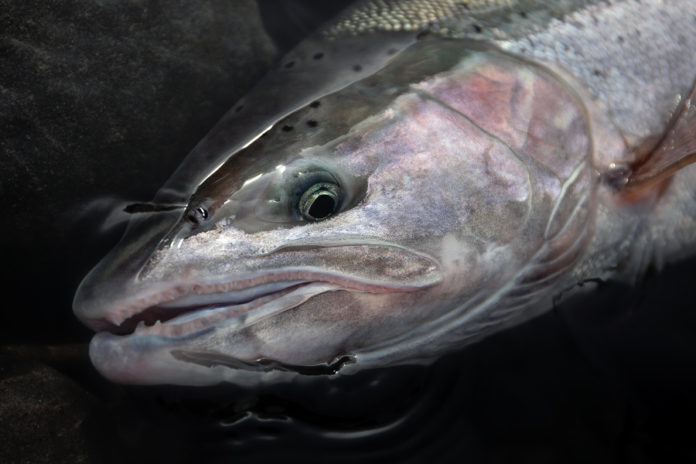Article and photos by: John R. McMillan
I enjoy fishing for steelhead more in winter than I do in summer, mostly because of the additional physical and mental challenges. Historically, there was perhaps no greater challenge in steelheading than catching a fish on a swung fly during the darkness of winter, especially with heavy single-handed rods, ineffective waders, crappy boots, and no internet to consult for stream flows or fishing reports. This year, the challenges of winter fishing will likely be even greater—no longer due to inadequate gear, but because of the lowest steelhead returns on record here on the West Coast.
Fishing success may be lower in poor-return years, but opportunity remains nevertheless, as I have learned over my 45 years of steelheading with a fly. Those long hours on the river provide a unique chance to improve your casting, mending, and presentation skills. This is how I’ve approached steelheading through the ebbs and flows of good and bad return years: invest in skills development during the crash, and then reap the rewards of your improvement when the runs rebound
For me, this began with night casting. During my first year, I struggled to efficiently and effectively cast my two-handed rod. A close friend of mine, Dave Steinbaugh, took me aside one day and made some casts while I sat on the bank and watched. I noticed that his anchor placement was different from mine, and realized I had been blowing mine time and again. Watching someone else provided a crucial moment of insight, like a light bulb of inspiration I had been missing. With my new realization, I improved, but not to the point where I was as good as Dave. That bothered me. I wanted to be better.

So, one night in late January 1999, after four consecutive fishless days, I had started the long, dark walk back to the truck when I suddenly stopped, recalling my blown anchors, and walked back down to the river bank. I attached a fly with a clipped hook, gave my dog a treat, waded back out into the run, and continued to cast.
Over the course of the next three hours, standing in the pitch-blackness, I began to feel the graphite flex through the tip and into the butt of the rod: Single Spey after single Spey, standing in the same spot, just casting into the void. I couldn’t see my line or my loops, nor where the fly was landing. I didn’t need to, because good casting is about feel. Just as athletes don’t need to look at the ball while dribbling, a proficient caster should have no need to look at their line, their D-loop, or their anchor.
I continued this practice each night, and after 110 consecutive nights of casting, it finally clicked. I could feel the momentum of each movement, and how it added purpose and power to the next. Every cast snapped my rod tip down to the water, hungry for more distance and power. I had found my stroke, but my night casting didn’t stop then. For the next decade, I routinely stayed on the river well into darkness, practicing my single Spey, double Spey, and snake roll.
At some point, I stopped practicing at night, as it was no longer necessary. Instead, when my casting began to falter, I would simply close my eyes and bring the darkness to me. That was usually enough to regain whatever feeling I had lost.

My point is not that night casting is a specific requisite for improvement, but rather that becoming a better steelheader requires more than just “fishing for catching.” It demands the development and mastery of certain skills, the foremost of which is line placement, and casting in the darkness is a great way to develop that particular skill.
If you live on the West Coast like I do, where steelhead returns will likely be poor this winter, there is still value to be gained during such times. Instead of focusing on catching fish, invest in your skill set. Seek out ways to become a more efficient, accurate, and powerful caster. That way, even if your winter’s hope isn’t answered with a grab, at least you will have honed your skills while enjoying nature, and you’ll be all the more prepared when the fish are more abundant again.
A lifelong steelhead angler, John McMillan has spent hundreds of days snorkeling steelhead rivers, observing the fish in their native habitat, and at one time he was fishing about 345 days a year. John currently serves as the Science Director for Trout Unlimited’s Wild Steelhead Initiative and has worked for the US Forest Service, the Hoh Indian Tribe, the Wild Salmon Center, and recently for NOAA on the Elwha Dam removal project.
Credit: Source link




























